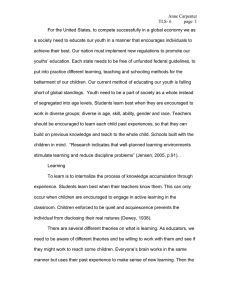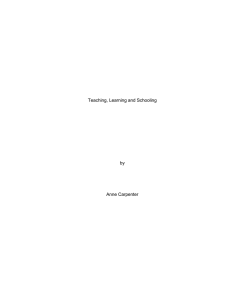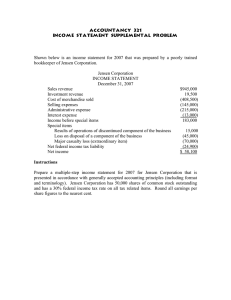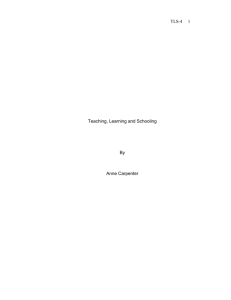Teaching, Learning and Schooling by Anne Carpenter
advertisement
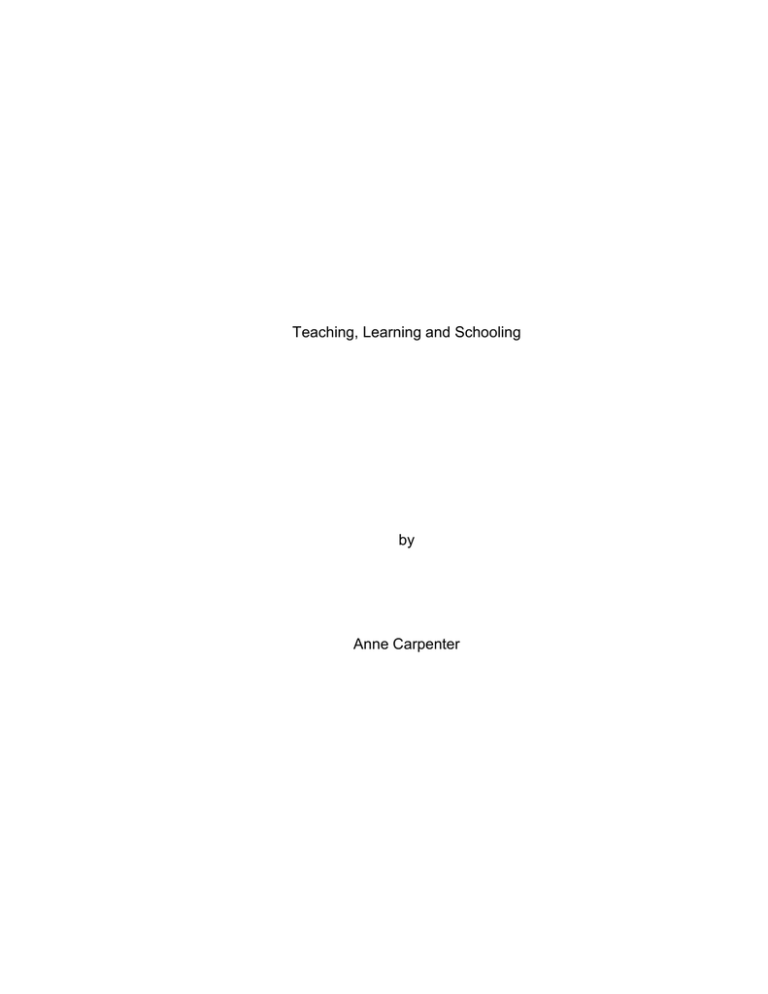
Teaching, Learning and Schooling by Anne Carpenter Anne Carpenter TLS- 7 page 2 For the United States, to compete successfully in a global economy as a society we need to educate our youth in a manner that encourages individuals to achieve their best. Our current method of educating our youth is falling short of global standings. For our youth to become active participants in our society our youth need to be a part of the whole society instead of segregated from society. Children who participate in society learn to become politically active members instead of passive witnesses who have no say in the decisions that affect them (Rousseau, 1762/2003). Current methods of teaching segregate students by age and teach individual subjects. Students learn best when they are encouraged to work in diverse groups; diverse in age, ability, gender and race. Teachers should be encouraged to learn each child’s past experiences, so that they can build on previous knowledge and teach the child holistically. To teach to the holistic child schools should be built with the child in mind. “Research indicates that well-planned learning environments stimulate learning and reduce discipline problems” (Jensen, 2005, p.91). . Learning To learn is to internalize the process of knowledge accumulation through experience. Students learn best when their teachers know them. This can only occur when children are encouraged to engage in active learning in the classroom. Children enforced to be quiet and acquiescent prevents the individual from disclosing their true nature (Dewey, 1938). There are several different theories on what is learning from the brain perspective, or as the environment affecting the individual or the individual affecting the Anne Carpenter TLS- 7 page 3 environment. As a society, we need to be aware of these different theories and be willing to try them to see if they work. Everyone’s brain works in the same manner but use their experience to make sense of new learning (Singer & Revenson, 1978/1996, Jensen, 2005). The more experiences we as teachers can expose children to the better they will learn. The brain learns by creating new dendrites. New information is transformed into neurotransmitters that pass from one dendrite to another through the synaptic gap. Then the neurotransmitter is changed into an electrical charge that travels though the axon to the terminal bud. In the terminal bud, the electrical charge is changed back to a neurotransmitter and passed on to the next dendrite. With practice, the new information strengthens the axon sheath in a process called myelination creating a super highway of information. If the information is gained in a new way then more dendrites are created. If the information is not used then the dendrites die in a process called synaptic efficiency where resources are moved to where they are needed (Jensen, 2005). Trail and error learning is need for our brains to get the information correct. Our brains do not get the information right the first time because we have too much stimulating our brains to be able to figure out the first time what we should remember. Our brains need 80 repetitions of new information before we will remember something (Ford, 2007 workshop). Making mistakes makes us smarter by reinforcing the myelination of our axon sheaths. “Feedback-driven learning makes more accurate and complex connections” (Jensen, 2005). Anne Carpenter TLS- 7 page 4 Learning according to behaviorists and Skinner (1971) takes place where we can observe the behavior and reward or punish it to strengthen or weaken the behavior. Children learn through positive or negative reinforcement. Positive reinforcement is when a child is rewarded for doing a behavior that is wanted. Like getting all the answers correct on a test and the child receiving a good grade. This causes the child to study harder to keep getting good grades. An example of negative reinforcement is when a parent nags a child to clean his/her room. The child cleans the room which causes the parent to stop nagging. To avoid further nagging in the future the child cleans the room more often. An example of punishment is when a child is not allowed to use the car for a month because they took the car without asking. The punishment causes the behavior to change and the child will now ask to use the car before taking it. Extinction is when an unwanted behavior is ignored causing the behavior to decreased. An example of this would be when a child uses inappropriate language and the adult ignores the language. If the child does not receive a response from the adult they will decrease and eventually stop the inappropriate language (Skinner, 1971). In contrast, Piaget and the constructivists believe that children learn by going through stages ( Singer & Revenson, 1978/1996). A child must be ready to learn something before they will be able to remember it. When a child experiences a new event, the child will initially try to fit it into an existing schema by assimilating because this is easiest. A schema is like a compartment in your roll top desk, when you encounter something new in your environment that makes sense to you it is placed in this compartment (assimilating). When the new event does not make sense then the compartment need to change to allow more events or use another compartment Anne Carpenter TLS- 7 page 5 (accommodation). If the event does not fit into an existing schema, the child becomes disequilibrated. The child can continue to use the existing schema and force the event into the schema but the child will continue to be disequilibrated. When the child creates a new schema to accommodate the new event then equilibrium is restored. When a child creates a new schema though assimilation and accommodation the child has adapted to their environment (Singer & Revenson, 1979/1996). Learning is based on previous cultural practices; this is what Piaget called a schema and Senge calls a mental model, and the use of cultural tools (Singer & Revenson, 1979/1996, Senge, 2006). These tools may be how the culture does math or writes. Some cultures appreciate slow, careful thought before answers and other cultures want quick answers (Rogoff, 2003). For the holistic child to learn every part of the child must be taken into consideration when teaching him/her. Teaching According to Skinner(1971) teaching is a way to guide a child to change behaviors from the ones we do not desire into ones we do. The use of rewards or punishment is the primary way to change behavior. However, Jensen (2005) states that the brain gets used to rewards and wants to increase the value of the reward. Another consideration is that a reward that works for one pupil will not work for another. Eventually the reward does not work (Jensen, 2005). “Working for the demeaning gold stars and letter grades” (Mooney & Cole, 2000). So rewarding a child for good behavior becomes an expensive endeavor and the result is not always a change in behavior. Anne Carpenter TLS- 7 page 6 Instead of teaching by changing behavior teaching the holistic child can be accomplish by teaching interdisciplinary programs that reflect real life. This is possible by cooperatively teaching, students to work in groups that are culturally, ability, racial, age, and sexually diverse. The reward system is group oriented rather than individual. This means the whole group must understand the material discussed before the reward is given. Having peers help each other in small groups encourages acceptance of diversity, teaches social skills and critical thinking (Arends, 1997). These learning environments are a model of society. Students work in small-groups to problem -solve current social issues and practice democratic processes in their interaction with each other (Dewey, 1916). Consequently, teaching the students how to be active members of society. Schooling Schooling is a wide-ranging institution made up of buildings, bureaucracy, social thoughts and cultural values. Rogoff (2003) stated: “…segregation of U.S. schoolchildren by age became formalized with the advent of compulsory schooling, which required a standard starting age to verify that children were not truant. Agegrading served bureaucratic needs in the face of great increases in the numbers of schoolchildren,” (p. 126). These changes occurred without considering what might be best for the holistic child and society as a whole. These changes were made to make it easier for the bureaucracy to keep track of children and teachers. This system produced vast numbers of society members who are witnesses to their political processes rather than active members(Rousseau, 1762/2003). Anne Carpenter TLS- 7 page 7 To accommodate the holistic child current school systems must evolve. “Schools with shattered windows, broken-down restrooms, leaky roofs, insufficient lighting, and overcrowding have a significantly negative impact on cognition” (Jensen, 2005, p. 91).The thoughts and values of current society must progress and be willing to help school the whole child. “Research indicates that well-planned learning environments stimulate learning and reduce discipline problems” (Jensen, 2005, p.91). Holistically schooling our children brings out the best in all children and prepares them for society. “Physical environments influence how we feel, hear and see. Those factors, in turn, influence cognitive and affective performance (Jensen, 2005, p.82)”. New school design should be with young people in mind. Chairs, tables and bathrooms need to fit the size of the child. Most buildings have poor lighting, are noisy, have bad air quality and are not conducive to learning. Success as a society in educating our youth will occur when we change the way we currently school and instead accommodate the child holistically. Granted, it will take society time to change and become more open to teaching, schooling and encouraging all children to learn holistically, however we must begin somewhere and we as teachers and member of society, can initiate the change. We can initiate the change by the teaching methods we chose to use in our classrooms, the values we choose to hold, the mental models we are willing to change and adapt to situations as needed. The environment we establish in our classroom can go along way toward creating a change that in time will improve our society by producing critical thinkers who become active members of our society. Also by having the love of teaching, to teach the best way we know and be willing to change when a new way comes along. Anne Carpenter References Arends, R. (1997). Classroom instruction and management. San Fran.: McGraw-Hill Dewey, J. (1916/1944). Democracy and education: An introduction to the philosophy of education. NY: The Free Press Dewey, J. (1963). Experience and education. NY: Macmillan. Jensen, E. (2005). Teaching with the brain in mind.(2nd ed.). Alexandria, Va: Association for Supervision and Curriculum Development. Mooney, J. & Cole, D. (2000). Learning outside the lines. NY: Fireside Books. Plato. (1995). Meno (B. Jowett, trans.). ILT Digital Classics. Retrieved September 11, 2007 from http://www.ilt.columbia.edu/publications/Projects/digitexts/plato/meno/meno.htm Rogoff, B. (2003). The cultural nature of human development. NY: Oxford University Press, Inc. Rousseau, J. (2003). On the social contract. (G.Cole, trans.). Dover thrift editions. NY: Dover Publications. Senge, P. (2006). The fifth discipline; The art & practice of the learning organization. NY: Doubleday Singer, D. & Revenson, T. (1978/1996). A piaget primer how a child thinks. NY: Plume Skinner, B. (1971). Beyond freedom & dignity. Indianapolis, Ind.: Hackett Pub. Wertsch, J. (1985). Vygotsky and the social formation of mind. Cambridge, Mass: Harvard University Press. Skinner, B. F. (2002). Beyond freedom & dignity. Indianapolis, Ind: Hackett Pub.
